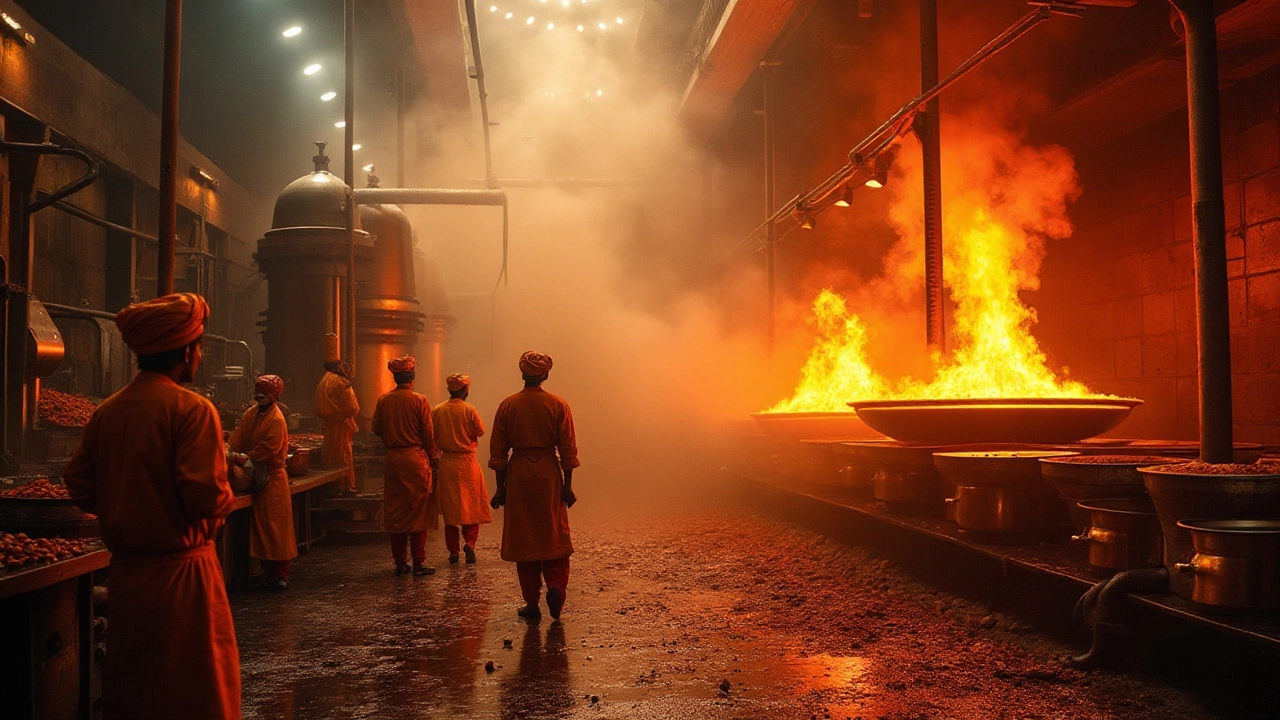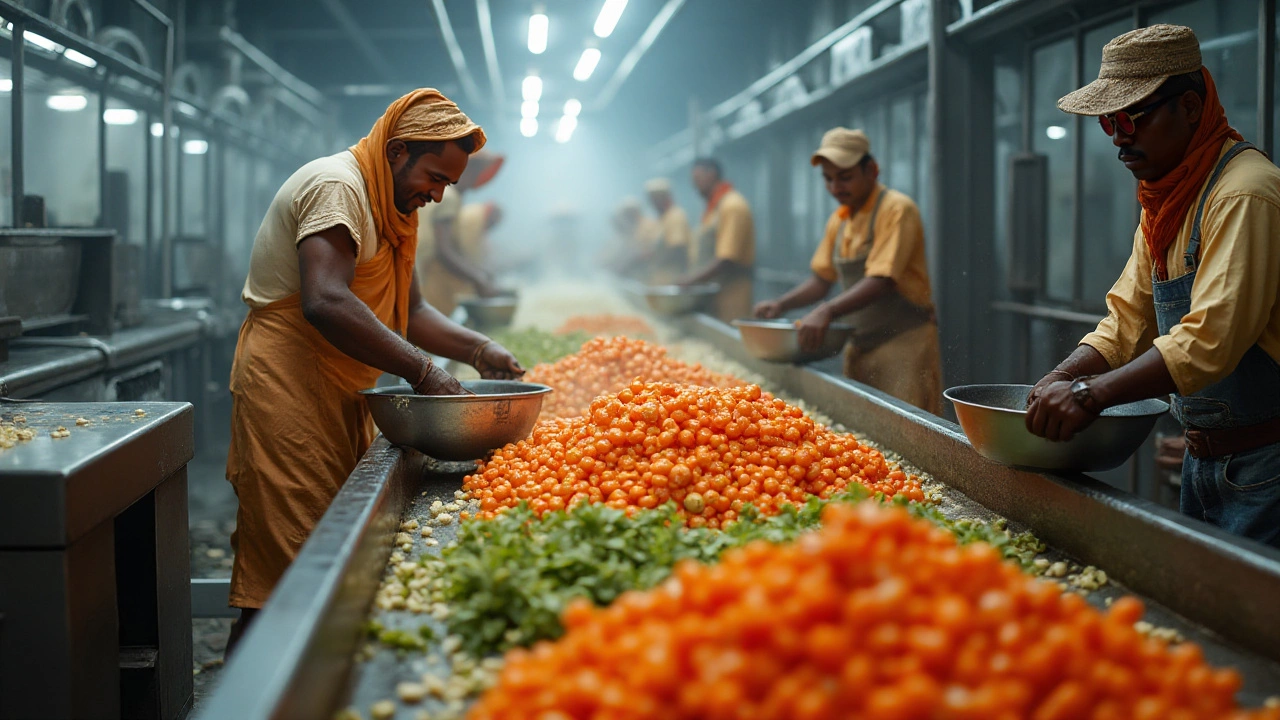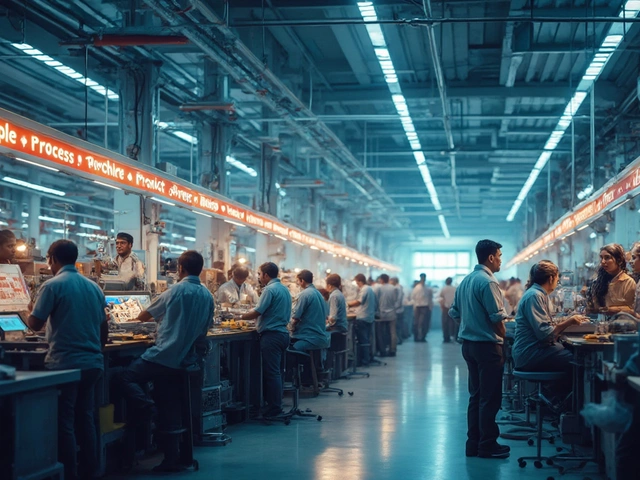Unit operations are like the hidden gears of the food industry machine, quietly working behind the scenes to bring tasty, safe, and efficient food products to our tables. From washing vegetables to bottling beverages, these operations ensure every step meets strict standards and innovative practices.
In food processing, a harmonious blend of art and science occurs. And it's not simply about cooking; it's about precise techniques and technologies aimed at transforming raw ingredients into delightful and delectable goods. Today, we'll explore the key unit operations, each playing a crucial role in food transformation.
- Cleaning and Sanitization
- Separation Techniques
- Heat Exchange Processes
- Size Reduction Methods
- Mixing and Blending
- Packaging Innovations
Cleaning and Sanitization
Cleaning and sanitization are foundational food processing unit operations, crucial for ensuring the safety and quality of the food we consume. These processes are not merely about washing away visible dirt or contaminants; they involve a meticulous removal of unseen microorganisms and residues that could compromise food safety. In the food industry, maintaining hygiene standards begins with understanding the specific requirements of each food product. Whether it's raw vegetables or delicate dairy products, each item demands a tailor-made approach to cleaning.
For instance, leafy greens might require a gentle washing technique using mild detergents and water that meets quality standards. Meanwhile, food processing of animal products often needs a more rigorous cleaning protocol, sometimes involving stronger cleaning agents and even sanitizing chemicals. The primary goal here is to mitigate any risk of microbial contamination, which remains one of the largest concerns in the food industry. According to the Centers for Disease Control and Prevention, foodborne illnesses affect about 48 million people annually in the U.S. alone, highlighting the importance of effective cleaning methods in food processing facilities.
Equipment and Methods
The equipment used in cleaning operations is as varied as the foods themselves. Some products might require the use of high-pressure sprayers, while others depend on immersion washers. With technological advancement, the industry has seen innovative solutions like ultrasonic cleaners, which use high-frequency sound waves to agitate food surfaces, effectively loosening contaminants. The choice of method influences the quality outcome significantly, demanding careful consideration from processors.Another critical component of sanitization involves the environment in which processing occurs. Floors, counters, and all contact surfaces are potential hotspots for contamination. Keeping these areas sanitized involves regular and thorough cleaning routines, often using approved disinfectants and periodically validated cleaning processes. Many processors prefer the use of automated systems for disinfecting equipment, providing a consistent and replicable cleaning process.
Regulations and Standards
Regulatory bodies around the world set guidelines that food processors must adhere to. In the U.S., for example, the Food Safety Modernization Act (FSMA) requires facilities to implement preventive measures in food safety management. This means standard operating procedures for cleaning and sanitization are well-documented, shared, and scrutinized regularly to maintain cleanliness and safety.“Without a doubt, proper cleaning and sanitization methods are vital for protecting public health and ensuring food quality. It's a non-negotiable step towards achieving industry excellence.” — Dr. Elaine Thompson, Food Safety Specialist
Compliance ensures not just consumer health but also the credibility of the food brand. As consumers grow increasingly aware of food safety issues, transparency regarding cleaning and sanitization processes can even become a selling point. After all, nothing ensures customer trust like knowing their food surpasses the highest safety standards.
Separation Techniques
In the realm of food processing, separating different components of a mixture is not just a matter of convenience; it's essential for ensuring the quality and safety of the final product. Separation techniques are the unsung heroes that allow us to selectively remove, isolate, or concentrate specific ingredients, thereby improving product uniformity and efficiency. This involves a variety of methods and technologies, each tailored to particular types of food and end-use requirements. From traditional sieving and filtration to cutting-edge membrane technologies, each technique plays a crucial role in the vast landscape of modern food production. Depending on the needs of the industry, separation processes can be mechanical, chemical, or thermal, and selecting the appropriate method requires a profound understanding of the materials involved along with the desired outcome.
The art and science of separation techniques often utilize principles grounded in physics and chemistry. For instance, milk pasteurization uses centrifugal forces to separate cream from milk, which not only facilitates the production of different dairy products but also enhances their taste and consistency. Technologies such as centrifugation and chromatography have become indispensable in manufacturing high-quality products. The use of energy, whether thermal or kinetic, must be optimized to ensure that the food processing remains cost-effective while maintaining quality. Some methods, such as filtration, are intuitive, involving the physical removal of unwanted solids or grains simply by passing the mixture through a porous barrier.
Advanced Technologies in Action
With the advancement of technology, more sophisticated methods like membrane filtration have emerged, providing the ability to separate particles on a molecular level. This method, akin to natural osmosis, offers precision by selectively allowing molecules to pass through a semi-permeable membrane. Notably, unit operations such as these in the dairy industry, help in producing whey protein concentrates and other valuable products. The process of microfiltration helps in brewing industries by clarifying and stabilizing beverages without compromising flavor.
“Modern membrane separation technologies are pivotal in producing high-quality drinks and reducing waste in food processing. They allow for more environmentally friendly manufacturing processes.”—Dr. Janet Matthews, Food Technology Specialist
For industries invested in sustainability, these processes provide a significant edge. Moreover, affordable and efficient separation techniques can enhance the food industry by cutting costs, minimizing waste, and optimizing resource utilization, thereby contributing to more sustainable practices. Technologies involving nanofiltration or reverse osmosis offer unique opportunities to innovate and refine food storage and production methods further. Ultimately, separation techniques are no longer just about getting rid of unwanted elements; they are a doorway to creating novel food textures, flavors, and nutritional profiles, all while promoting eco-friendly approaches.

Heat Exchange Processes
When discussing food processing, one cannot overlook the importance of heat exchange processes. These processes are pivotal in ensuring that foods are not only delicious but also safe to consume. Heat exchange involves controlling and manipulating temperatures of foodstuffs, a necessity for achieving the desired texture, taste, and, most importantly, safety by killing harmful microbes.
Heat exchange can take several forms, with common methods including pasteurization, sterilization, and blanching. Pasteurization, particularly in dairy and juice products, is a process where liquids are heated to specific temperatures to kill off harmful bacteria without compromising the nutritional value. This balance is crucial, as it ensures the product remains beneficial to the consumer. Traditional pasteurization methods have evolved, with high-temperature short-time (HTST) pasteurization being widely used to maintain quality and prolong shelf life.
Sterilization takes heat exchange a notch higher by completely eliminating all forms of microbial life. This is essential for products that require a longer shelf-life, often found in canned goods. Interestingly, the process requires precise temperature control—a challenging feat perfected over numerous years of technological advancements. Did you know that the inception of modern canning in the early 19th century has paved the way for these techniques by combining both science and creativity?
Blanching, often a preparatory step, involves briefly boiling vegetables and fruits before freezing. This seemingly simple act halts enzyme actions, preserving the color, flavor, and nutrients of the produce, making it a favored technique in the food industry. Though the mechanics may seem daunting, it's these very processes that ensure the produce retains the vital properties beneficial to our health.
"In food processing, heat exchange is not merely about cooking; it’s a precise science of balancing safety, flavor, and texture," explains a senior food technology expert at the Institute of Food Technologists.
As we delve into modern innovations, heat exchange methods are increasingly adopting eco-friendly practices. Innovations such as regenerative heat exchangers are emerging, which cleverly re-use heat energy, thus reducing the overall energy consumption. It is this creativity, combined with scientific advancements, that continues to shape the landscape of food processing. The next time you pick up a carton of milk or enjoy canned fruits, you'll witness the invisible hand of heat exchange processes ensuring the product is safe, flavorful, and aesthetically pleasing, all thanks to the magic entailed in food processing.
Size Reduction Methods
In the bustling world of food processing, size reduction is a fundamental operation, vital for enhancing the texture, flavor, and shelf life of various products. Whether it's grinding spices for seasoning, chopping vegetables for canned soups, or milling grains into flour, proper size reduction ensures the consistency and quality that consumers expect. Imagine savoring your favorite chocolate bar; it owes its silky texture partly to the size reduction of its cocoa beans, processed meticulously to achieve that perfect melt-in-your-mouth feel.
This process isn't a one-size-fits-all operation; it varies significantly depending on the food product. In many instances, processors deploy a variety of mechanical forces—such as compression, impact, and shear—to achieve the desired particle size. When reducing the size of solid foods, tools like grinders, mills, slicers, and dicers come into play, each tailored to handle different textures and densities, offering flexibility and precision in the processing line. The selection of the right equipment impacts not only efficiency but also energy consumption and product quality, a fine balance that the industry aims to maintain.
A crucial factor in the size reduction method is understanding the innate properties of the food material. Products with high moisture content, like fresh vegetables, respond differently to cutting compared to drier materials like grains or nuts. The latter often require milling machines, while high-moisture foods benefit from chopping or slicing. When it comes to seeds and spices, for instance, grinding ensures a finer texture, enhancing aroma and taste—a crucial aspect in seasoning, where freshness and fragrance carry significant commercial value.
Modern Technologies in Size Reduction
Technological advancements have revolutionized size reduction practices in recent years. Ultrasonics, for instance, have emerged as a non-conventional method, offering precise control while preserving delicate flavors and nutrients. This is particularly valuable in the food industry, where high-quality standards must be met. Another leap forward is cryogenic grinding, where materials are cooled to extremely low temperatures with liquid nitrogen before processing. This innovative approach not only enhances energy efficiency but also prevents product degradation due to heat, making it invaluable for temperature-sensitive substances such as certain spices and herbs.
“The role of size reduction is pivotal in not only achieving the desired physical properties but also in impacting the chemical and functional properties of food,” describes Professor Howard Zhang, a renowned food technology expert.
While employing these sophisticated techniques, the industry also keeps a close eye on sustainability and energy efficiency. After all, responsible food processing requires reducing waste and minimizing environmental impact. As such, high-efficiency equipment that consumes less power and generates less heat is increasingly being adopted, aligning with global eco-friendly initiatives. This marriage of innovation and responsibility stands at the forefront of modern food technology, shaping a future where taste, quality, and sustainability go hand in hand.
| Technique | Application | Advantage |
|---|---|---|
| Cryogenic Grinding | Spices, Coffee | Preserves Aroma |
| Ultrasonics | Fruits, Vegetables | Maintains Nutrients |
| Milling | Grains, Nuts | Fine Consistency |

Mixing and Blending
When we talk about the essential practices in food processing, mixing and blending stand out as foundational processes that elevate culinary endeavors and industrial food production alike. The essence lies in homogeneously combining ingredients, ensuring consistent texture, taste, and even appearance. Picture your favorite cookie dough or a smooth sauce—without proper blending, the ingredient harmony would not exist. Modern food plants employ sophisticated mixers, ranging from basic hand-held options to vast industrial machines capable of churning out tons of mixed product per hour. Each piece of equipment is tailored to handle specific tasks, from delicate liquids to stubborn, dense dough.
Why is mixing so important? Beyond just combining ingredients, it also infuses air to create lightness, disperses flavors evenly, and helps reach the desired consistency. For example, in the beverage industry, thoroughly mixing ensures that flavors or carbonation aren't unevenly distributed, potentially leading to disappointing tastes. Furthermore, the choice of mixing method can even affect the shelf-life of a product as well as its nutritional value. The classic battle between batch and continuous mixing reflects on the strategies industries adopt based on scale and nature of production. For many solid components, blending and mixing aren't accomplished in the same step, but rather incrementally, ensuring all constituents are appropriately integrated.
Imagine a kitchen without a whisk, a mixer, or even a simple spoon—it sounds like an unthinkable loss of efficiency. Significant decisions go into choosing the type of mixers utilized in food technology; factors like ingredient reactivity, texture, and temperature sensitivity all play pivotal roles. Companies sometimes leverage advanced tools like shear mixers for highly viscous materials or ribbon blenders for dry components. Increasingly, technology continues to drive innovation, integrating automation that ensures precise mixing under optimal conditions. According to a study published in the Food and Bioproducts Processing Journal, innovations in mixing technology can reduce energy consumption by 20% while increasing output.
"Adopting modern mixing techniques not only enhances product quality but also significantly economizes the production line," observes Dr. Emily Nguyen, a recognized expert in food technology.
Mastering mixing and blending is both an art and a science, offering as much creativity as it does technicality, ensuring that whether mixing a five-ingredient pastry or a complex seasoning blend for mass production, the results are consistently delicious. Industrial advancements in mixers allow manufacturers to experiment with textures and flavors far beyond traditional capacities, propelling new product lines into supermarkets worldwide. As the heart and soul of many food industry operations, the significance of this practice cannot be overstated, blending tradition with technology.
Packaging Innovations
The art and science of food packaging are continuously evolving, shaped by innovations catering to sustainability, safety, and consumer convenience. Today, packaging goes beyond its primary function of containment, offering a suite of benefits that boost product appeal and functionality. The impact of these innovations is profound, sparking a shift in how the food industry approaches packaging—transforming it into a critical aspect of modern food processing.
At the forefront of these innovations are materials designed to improve sustainability. Biodegradable and compostable options have emerged as popular alternatives to conventional plastics, reducing the environmental footprint of packaging. Materials made from plant-based sources, like PLA (Polyactic Acid), break down naturally over time, addressing growing environmental concerns about pollution. This shift reflects a broader industry commitment to sustainable practices, as companies seek to make a positive impact on the planet through food processing.
Advancements in smart packaging also highlight significant strides within the industry. These innovative solutions incorporate technology to provide benefits such as extended shelf life, improved safety, and enhanced user experience. QR codes and NFC tags integrated into packaging offer transparency and traceability, allowing consumers to access information about sourcing, nutritional content, and freshness with a quick scan. This transparency not only aids informed decision-making but also fosters brand trust, enhancing customer loyalty.
"Smart packaging delivers both functionality and value, effectively bridging the gap between producers and consumers," notes a report from the Food Packaging Forum.
Packaging innovations also address the challenge of food waste, a pressing issue in today's society. With features like resealable closures, portion-controlled packaging, and advanced barrier technologies, the goal is to preserve freshness and prevent spoilage, ultimately reducing waste. Oxygen scavengers and moisture-wicking materials, for instance, are incorporated to extend shelf life and maintain product quality, ensuring the fresh taste consumers expect. These innovations demonstrate how companies are investing in technology to mitigate food waste and its environmental and economic consequences.
Beyond functionality, packaging is increasingly seen as a vehicle for expression, with eye-catching designs and marketing messages. The integration of high-quality graphics and interactive elements elevates the consumer experience, engaging customers and differentiating products in a crowded marketplace. Unique shapes, textures, and finishes invite consumer interaction, enhancing perceived value and making the packaging a critical aspect of the branding strategy.
To provide a comprehensive overview of current trends, here are a few statistics highlighting the growth in sustainable and smart packaging:
| Trend | Statistic |
|---|---|
| Sustainable Packaging | Projected to grow by 5.5% annually to reach $470 billion by 2027 |
| Smart Packaging | Expected annual growth rate of 11.1% through 2025 |
These data points underscore the direction in which the industry is moving, driven by consumer demand and technological advancements. As such, innovations in packaging will continue to redefine how we approach food products, marrying practicality with environmental stewardship. The result is a dynamic landscape that prioritizes both human convenience and ecological sustainability, ensuring packaging remains a pillar of food technology progress.





